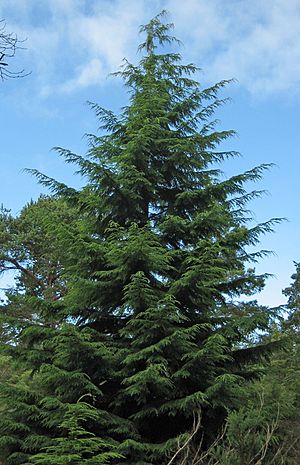Tsuga facts for kids
Quick facts for kids Tsuga |
|
|---|---|
| Scientific classification |
|
| Kingdom: | Plantae |
| Clade: | Tracheophytes |
| Division: | Pinophyta |
| Class: | Pinopsida |
| Order: | Pinales |
| Family: | Pinaceae |
| Subfamily: | Abietoideae |
| Genus: | Tsuga (Endl.) Carrière |
| Synonyms | |
|
|

Tsuga is a group of conifer trees, also known as hemlocks. These trees are part of the Pinaceae, or pine family. The name "hemlock" comes from how their crushed leaves smell, which is a bit like the poisonous plant called hemlock. But don't worry, Tsuga trees are not poisonous!
There are about eight to ten different kinds of hemlock trees. Four of these grow in North America, and the rest are found in eastern Asia.
Contents
What are Hemlock Trees Like?
Hemlock trees are medium to large evergreen trees. They can grow from about 10 to 60 meters tall. Their tops are usually shaped like a cone, but some Asian types can have a more uneven shape. The very top branches often droop downwards.
Their bark is scaly and often has deep grooves. It can be grey or brown. The branches grow out from the main trunk and usually spread out flat, bending down at their ends.
Hemlock Leaves
Hemlock leaves are flat or slightly angled. They are usually between 5 and 35 millimeters long and 1 to 3 millimeters wide. Each leaf grows separately and spirals around the stem. The base of each leaf twists so that the leaves lie flat on either side of the stem, or sometimes all around it.
If you look at the underside of a hemlock leaf, you'll see two white lines. These lines are where the tree "breathes" through tiny pores called stomata. The top side of the leaves usually doesn't have these pores, except for one type called T. mertensiana.
Reproduction: Cones and Seeds
Hemlock trees have two types of cones:
- Pollen cones: These are small, usually 3 to 5 millimeters long. They can be oval, round, or egg-shaped and are yellowish-white to light purple. These cones release pollen.
- Seed cones: These grow on branches that are a year old. They are small, usually 15 to 40 millimeters long, and hang downwards. The seeds inside mature in about 5 to 8 months. Once the seeds are ready, they fall out, and the cones usually drop off soon after.
The seeds are small, about 2 to 4 millimeters long, and have a wing that helps them fly away in the wind.
Where Do Hemlock Trees Come From?
Scientists have found very old hemlock tree fossils, including twigs, that are from the Early Cretaceous period. This means hemlocks have been around for a very long time! They were once found in Europe, but they died out there during the Ice Ages because the climate became too cold.
Different Types of Hemlock
Here are some of the main types of hemlock trees:
- Tsuga canadensis – Eastern hemlock (found in Eastern Canada and the United States)
- Tsuga caroliniana – Carolina hemlock (found in the Southern Appalachians)
- Tsuga chinensis – Taiwan hemlock (found in Taiwan, Tibet, and much of China)
- Tsuga diversifolia – Northern Japanese hemlock (found in Honshu, Kyushu, Japan)
- Tsuga dumosa – Himalayan hemlock (found in the Himalayas, Tibet, China)
- Tsuga forrestii – Forrest's hemlock (found in China)
- Tsuga heterophylla – Western hemlock (found in Western Canada and the Northwestern United States)
- Tsuga mertensiana – Mountain hemlock (found in Alaska, British Columbia, and the Western United States)
- Tsuga sieboldii – Southern Japanese hemlock (found in Japan)
- Tsuga ulleungensis – Ulleungdo hemlock (found on Ulleung Island, Korea)
Hemlock Habitat and Threats
Hemlock trees like cool, moist places with lots of rain and mild summers. They can handle heavy snowfall and ice storms better than most other trees. They also do well in shady areas, but they don't like dry conditions.
Threats to Hemlocks
Two types of hemlock in eastern North America, T. canadensis and T. caroliniana, are in danger from a tiny insect called the hemlock woolly adelgid. This insect sucks the sap from the trees. It came from eastern Asia, where it doesn't cause much harm. But in North America, it has killed many hemlock trees, especially near the Appalachian Mountains. The hemlocks in Asia are naturally resistant to this pest.
Other threats include:
- Hemlock looper: Another insect that attacks hemlocks in North America.
- Fungal diseases: Older trees can get sick from various fungi that rot their wood. This can make the trees weak and cause them to fall over in strong winds.
- Animals: Young hemlock trees are often eaten by deer. Small birds like finches and tiny rodents also eat their seeds.
How People Use Hemlock Trees
Hemlock wood is very important in the timber industry. It's often used to make wood pulp, which is then used to make paper. Many types of hemlock trees are also grown in gardens and parks because they look nice.
The bark of hemlock trees is used in tanning leather. Sometimes, the needles are even used to make tea or perfume!
Images for kids
-
T. canadensis leaves stay on the tree for 3–4 years.
-
T. mertensiana foliage and cones.




